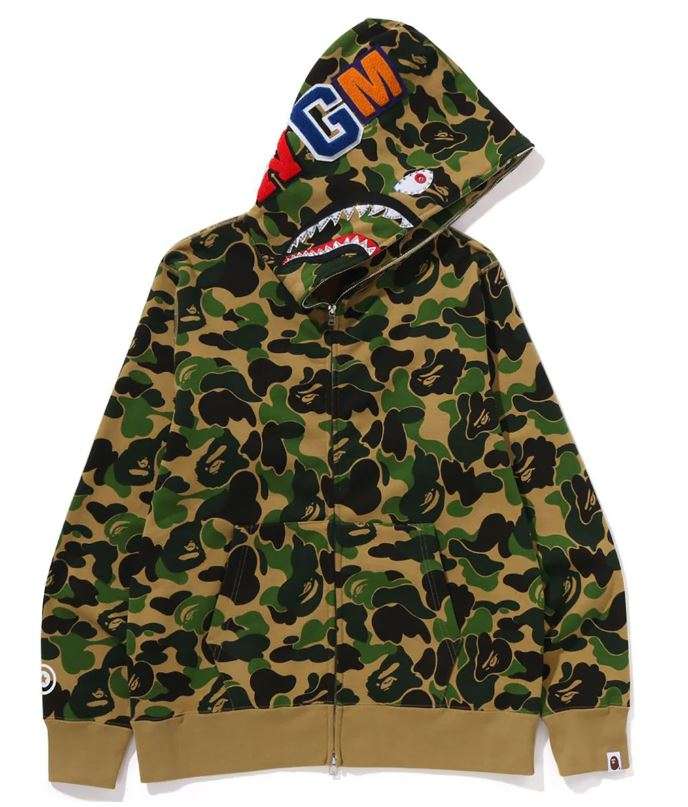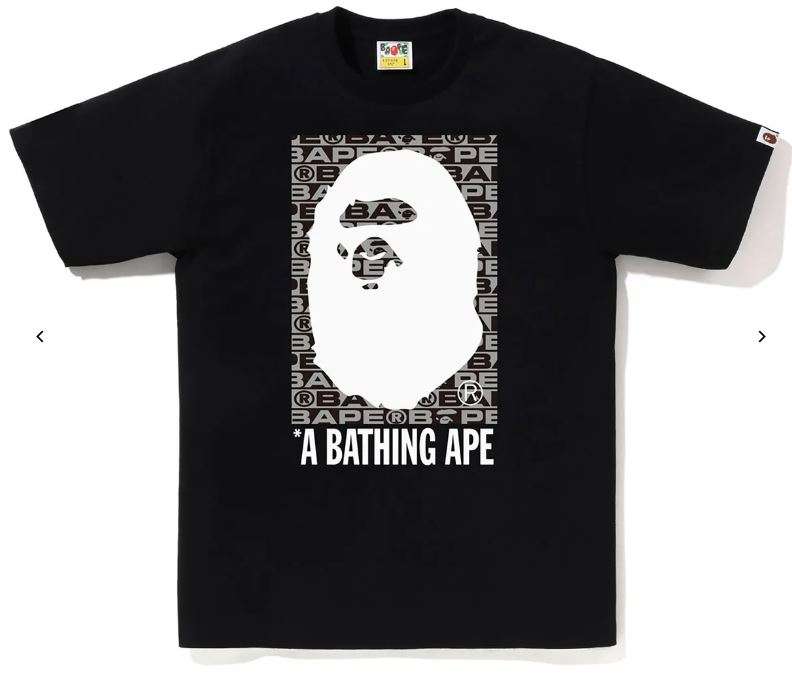
22 Apr Origins of the Iconic BAPE Logo
Searching for what is the hottest fashion, t-shirts, and streetwear you will inevitably run into A Bathing Ape (Bape).
They are still at the top of Google searches for clothing. From its origins to its influence on streetwear culture, we delve deep into what makes A Bathing Ape an iconic and innovative brand.
In the dynamic world of fashion, few names evoke as much recognition as “A Bathing Ape,” – AKA Bape. With its revolutionary designs and street-style aesthetics, Bape has carved an indelible niche in the world of streetwear. They are somewhat of a cultural phenomenon, making an enormous impact on fashion, continuing to captivate both celebrities and fashion enthusiasts.
A Bathing Ape: A Revolution in Streetwear
A Bathing Ape, commonly abbreviated as Bape, was established in 1993 by Nigo, a Japanese designer and music producer. The name itself is a nod to the idiom “bathing ape in lukewarm water,” which means to live a relaxed and leisurely lifestyle. Bape’s iconic camouflage patterns, bold graphics, and unique color schemes have redefined urban fashion. From its early days in Harajuku, Tokyo’s fashion district, to becoming a global phenomenon, A Bathing Ape’s journey is a testament to innovation and creativity.
What is the history behind A Bathing Ape’s name? The name “A Bathing Ape” is derived from the Japanese idiom “bathing ape in lukewarm water,” which signifies living a relaxed and leisurely lifestyle. It captures the essence of the brand’s easygoing yet stylish approach to fashion.
A Bathing Ape’s Influence on Streetwear Culture
Bape’s impact on streetwear culture cannot be overstated. The brand’s collaborations with artists, designers, and musicians have resulted in limited-edition collections that are eagerly awaited by fans. Bape’s distinctive designs have graced the wardrobes of celebrities like Pharrell Williams, Kanye West, and Jay-Z, solidifying its status as a symbol of urban cool.
Origins of the Iconic BAPE Logo
Like most of the Japanese streetwear icons, BAPE’s roots can be traced back to the ura-Harajuku scene of the early ’90s. Most of today’s heavyweights — Shin Takazawa of Neighborhood, Tetsu Nishiyama of WTaps, Hiroshi Fujiwara, Sk8thing and so on — were actually a group of friends in the same scene, each doing their own thing and helping each other out along the way.
After a few years working as an editor and stylist at Popeye magazine, Nigo opened up his store ‘Nowhere’ with Jun Takahashi of Undercover, and shortly after worked with Sk8thing to launch his own clothing brand, A Bathing Ape — or BAPE.
Nigo is a notorious fan of 20th century pop culture, and channelled his love for the 1968 film Planet of the Apes in the name and iconic BAPE logo, as well as referring to the Japanese idiom ‘A bathing ape in lukewarm water.’ The phrase is used to describe somebody who overindulges, like lying in a bath until the water isn’t even hot anymore, so was an almost tongue-in-cheek reference to the same hyper-consumptive youth that would eventually form the cornerstone of his brand.
The original reason for BAPE’s scarcity was arguably one of financial necessity – Nigo started out on a tight budget and only afford to produce around 50 T-shirts a week – but he also disliked the idea of everyone wearing the same thing.
The Steady Decline & Nigo’s Departure
Though the BAPE story wouldn’t be the same without its meteoric rise to success in the States, the brand’s newfound popularity brought with it a number of problems. Scarcity of product in the U.S., combined with BAPE’s unusually high prices for young western consumers, led to the proliferation of counterfeit product, saturating the market before the brand could find its feet. BAPE’s relatively-sudden explosion also meant that its popularity became more of a fad or passing trend than the slow and carefully-cultivated hype that it had built in Japan.
By 2010 the brand had fallen out of vogue, and it emerged that A Bathing Ape had amassed over 2.5 billion yen ($22.5 million) in debt. Nigo stepped down from the company as CEO, and in 2011 the brand was sold to Hong Kong fashion conglomerate I.T for a paltry $2.8 million. Over the next two years Nigo stayed with the company to assist with the transition, launching his new vintage-inspired label Human Made and taking on a new role as Creative Director of Uniqlo’s ‘UT’ T-shirt line.
BAPE Today
Since its acquisition by I.T, BAPE has settled as a mainstay label of contemporary streetwear; though the brand is nowhere near as scarce and unpredictable as it used to be, its legacy as one of the original streetwear icons, as well as its deep connections in hip-hop and street culture, has seen the brand endure with a much broader audience.
Once-coveted rarities like BAPE shark hoodies and insulated snow jackets have become mainstay pieces every season, and the brand’s iconic camo is now one of the most prolific graphics of contemporary street style. To many of the older heads, the BAPE of today has little in common with its roots, but whether that’s a good or bad thing is, frankly, a matter of perspective. In 2017, it’s still a brand defined by its young, consumptive audience’s voracious appetite for anything on offer, so in many ways it’s the same as it ever was.
Why is BAPE so expensive?
Very few discussions about BAPE ever pass by without that vital inquiry; just why, exactly, is BAPE so expensive? The thing is, with a lot of Japanese brands, there’s a long list of reasons behind their pricing structure; higher standards of quality, better healthcare and wages for Japanese manufacturers, a consumer perspective in Japan that good product is worth having and worth paying the price for, and so on.
The thing with BAPE though, these days at least, is that none of that is really the case. The product is mostly made in China. The quality, though still good compared to your average mall brand, is really nothing special. And as for its reputation in Japan, BAPE is hardly an exceptional label. In fact, it’s so common over there that most people probably wouldn’t bat an eye at it.
So why is BAPE so expensive? Sit down for the revelation: because it just is. Remember the meaning behind the name? Complacent and over-indulgent youth? Ding ding ding. BAPE is expensive because it’s an expensive brand for kids with too much money, and that tongue-in-cheek treatment of its customer just ended up also being one of its strongest appeals.
Buying BAPE
Be warned, however; the risk of buying counterfeit product from an unofficial seller is as real as ever, but there are comprehensive guides on how to identify fakes available with a simple Google search. If you’re not an expert on BAPE product (and to be honest, even if you are), take the time to learn what you’re buying and save yourself the hassle of opening up a package full of fake garments bought from some sketchy BAPE Online Discount Bargain Super Value Outlet.
A Bathing Ape’s journey from its humble beginnings in Tokyo’s Harajuku district to its current global acclaim is a testament to the brand’s innovation and cultural impact. With its distinctive designs, collaborations that make headlines, and a loyal community of enthusiasts, Bape continues to shape the world of streetwear and inspire the next generation of fashion trendsetters.A Bathing Ape: Unveiling the Trendsetting Streetwear Icon


